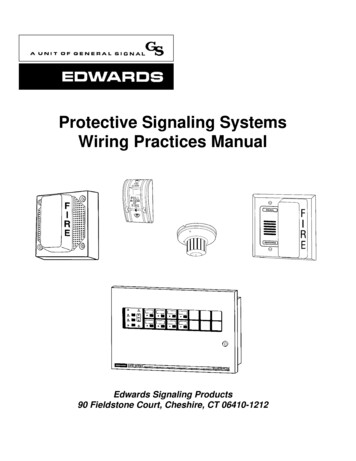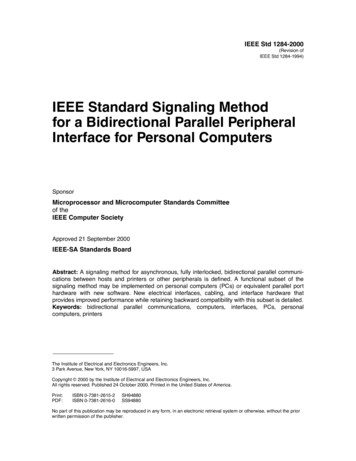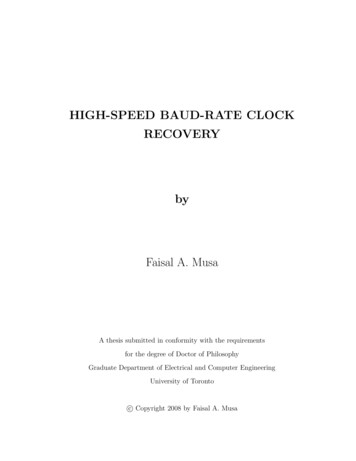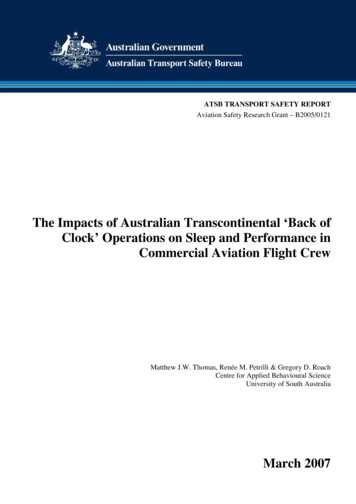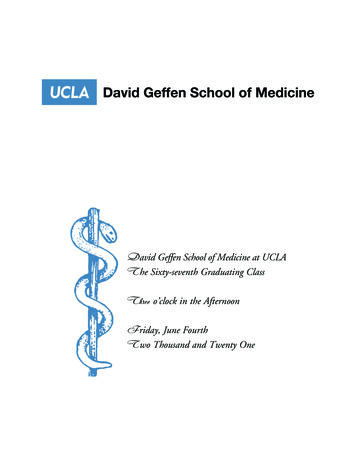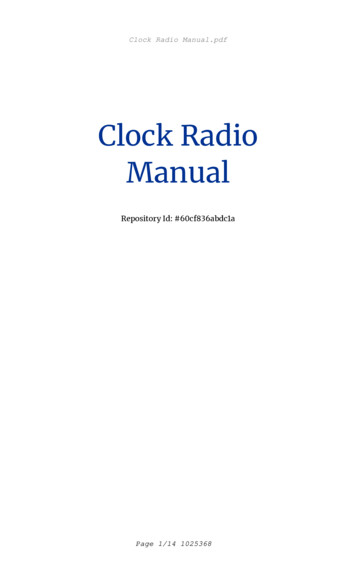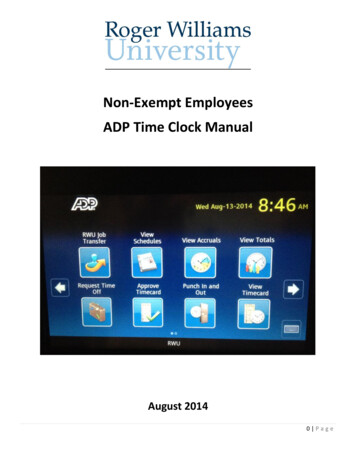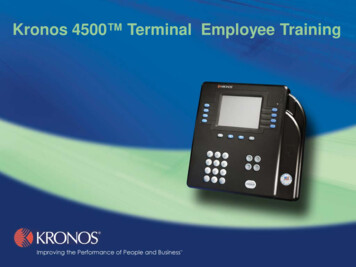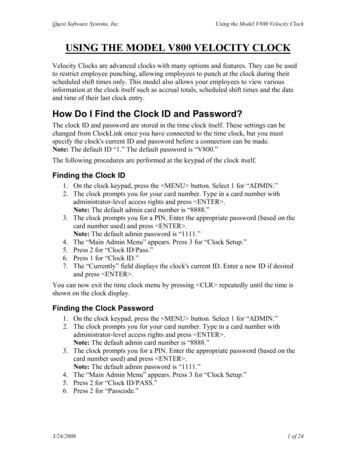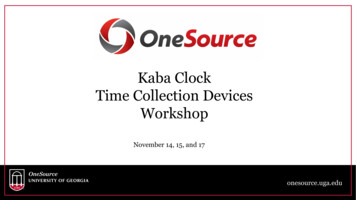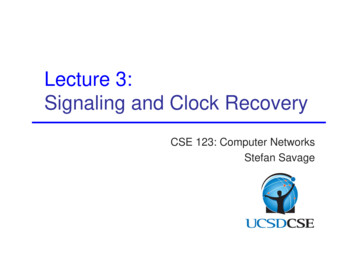
Transcription
Lecture 3:Signaling and Clock RecoveryCSE 123: Computer NetworksStefan Savage
Last time Protocols and sicalPhysical Layer encapsulation via packet headersEthernet HdrdatalinkIP HdrTCP Hdrnetwork transportHTTP HdrapplicationPayload (Web object)
Today How to send data from point A to point B over somelink?
Copper Typical examples Category 5 Twisted PairCoaxial Cable10-1Gbps10-100Mbps50-100m200mtwisted paircoaxialcable(coax)copper coreinsulationbraided outer conductorouter insulation4
Fiber Optics Typical examples Multimode FiberSingle Mode Fiber10Gbps100Gbps300m25kmCheaper to drive(LED vs laser) &terminateLonger distance(low attenuation)Higher data rates(low dispersion)5
Wireless Widely varying channel bandwidths/distancesExtremely vulnerable to noise and dioSatelliteFiber108 1010 1012 1014Microwave IRFreq (Hz)Light UV6
Aside: Wireless spectrum Shared medium - regulated useWireless frequency allocations
Spectrum Allocation Reality is that spectrum is timeand power shared Measurements show that fixedallocations are poorly utilized0Frequency (Hz) Policy approach forces spectrum to beallocated like a fixed spatial resource(e.g. land, disk space, etc)Time (min)Whitespaces?8
Overview for today Digital Signaling Why?Shannon’s Law and Nyquist LimitEncoding schemes Clock recoveryManchester, NRZ, NRZI, etc. A lot of this material is not in the book Caveat: I am not an EE Professor9
Signals:10,000 foot review of digital vs analog Data can be represented continuously as an analogwaveOr as a series of discrete digital symbols0 0 1 0 1 1 1 0 0 0 1 Why is the digital representation so powerful? Noise resistance: has to be a 0 or 1Storage/reproducibility: analog waves can be converted todigital for storage and then back to analog (think about CDs)
Overall Goal: Send bits A three-step process Take an input stream of bits (digital data)Modulate some physical media to send data (analog)Demodulate the signal to retrieve bits (digital again)Anybody heard of a modem (Modulator-demodulator)?digital data(a string ofsymbols)0101100100100modulationdemodulationa signaldigital data(a string ofsymbols)010110010010011
A Simple Signaling System12
Signals and Channels A signal is some form of energy (light, voltage, etc) Varies with time (on/off, high/low, etc.)Can be continuous or discreteWe assume it is periodic with a fixed frequencyA channel is a physical medium that conveys energy Any real channel will distort the input signal as it does soHow it distorts the signal depends on the signal and thechannel 13
Channel Properties Bandwidth-limited Power attenuates over distance Signal gets softer (harder to “hear”) the further it travelsDifferent frequencies have different response (distortion)Background noise or interference Range of frequencies the channel will transmitMeans the channel is slow to react to change in signalMay add or subtract from original signalDifferent physical characteristics Point-to-point vs. shared mediaVery different price points to deploy14
Channel Challenges Every channel degrades a signal Distortion impacts how the receiver will interpret signalresponseidealactualfreqB15
Impact of distortion & noise
Two Main Tasks First we need to transmit a signal Then we need to receive a (degraded) signal Determine how to send the data, and how quicklyFigure out when someone is sending us bitsDetermine which bits they are sendingA lot like a conversation “WhatintheworldamIsaying” – needs punctuation and pacingHelps to know what language I’m speaking17
The Magic of Sine Waves All periodic signals can be expressed as sine waves Sine waves are “nice” Component waves are of different frequenciesPhase shifted or scaled bymost channels“Easy” to analyze Fourier analysis can tellus how signal changesBut not in this class 18
Carrier Signals Baseband modulation: send the “bare” signal E.g. 5 Volts for 1, -5 Volts for 0All signals fall in the same frequency rangeBroadband modulation AmplitudeAmplitude Use the signal to modulate a high frequency signal (carrier).Can be viewed as the product of the two signalsSignalCarrierFrequencyModulatedCarrier19
Forms of Digital ModulationInput SignalAmplitude Shift Keying(ASK)Frequency Shift Keying(FSK)Phase Shift Keying(PSK)CSE 120 – Lecture 1: Course Introduction20
Why Different Schemes? Properties of channel and desired application Efficiency Some modulations can encode many bits for each symbol(subject to Shannon limit)Aiding with error detection AM vs FM for analog radioDependency between symbols can tell if a symbol wasn’tdecoded correctlyTransmitter/receiver Complexity21
Inter-symbol Interference Bandlimited channels cannot respond faster thansome maximum frequency f Attempting to signal too fast will mix “symbols” Channel takes some time to “settle”Previous symbol still “settling in”Mix (add/subtract) adjacent symbolsLeads to inter-symbol interference (ISI)OK, so just how fast can we send symbols?22
Speed Limit: Nyquist In a channel bandlimited to frequency f, we can sendat maximum symbol (baud) rate of 2f without ISIDirectly related to Nyquist sampling theorem Can reconstruct signal with maximum frequency f, bysampling at least 2f times per second23
Multiple Bits per Symbol OK, but why not send multiple bits per symbol? E.g., instead of 3V 1 and 0V 0, multiple levels» 0V 00, 1V 01, 2V 10, 3V 11, etc Four levels gets you two bits, log L in general3V10V1110010003V2V1V0VCould we define an infinite number of levels?24
Shannon’s law: noise kills S signal power, N noiseChannel noise limits bit density Intuitively, need level separation» E.g., what if noise is 0.5V and you readsignal of 1.5V. what symbol is that? Can combine this observation with Nyquist(and some more math) Can only get log(S/2N) bits per symbolC B log (1 S/N) Shannon/Nyquist Capacity limitExample: old modems (B 3000Hz, S/N 30dB 1000) C 3000 x log(1001) 30kbps25
Next problem: Clock recovery How does the receiver know when to sample thesignal? Sampling rate: How often to sample? Sampling phase:» When to start sampling? (getting in phase)» How to adjust sampling times (staying in phase)
Sampling at the Receiver Need to determine correct sampling frequency Signal could have multiple interpretationsWhich of these is correct?00110011Signal0101Signal27
Nyquist Revisited Sampling at the correct rate (2f) yields actual signal Always assume lowest-frequency wave that fits samplesSampling too slowly yields aliases28
The Importance of Phase Need to determine when to START sampling, too29
Clock Recovery Using a training sequence to get receiver lined up Need to combat clock drift as signal proceeds Send a few, known initial training bitsAdds inefficiency: only m data bits out of n transmittedUse transitions to keep clocks synched upQuestion is, how often do we do this? Quick and dirty every time: asynchronous codingSpend a lot of effort to get it right, but amortize over lots ofdata: synchronous coding30
Asynchronous Coding Encode several bits (e.g. 7) together with a leading“start bit” and trailing “stop bit”Data can be sent at any timeStart bit transition kicks of sampling intervals Can only run for a short while before drifting31
Example: RS232 serial lines Uses two voltage levels ( 15V, -15V), to encodesingle bit binary symbolsNeeds long idle time – limited transmit rate 15Voltage -15idle start 10 0 1 1 0 0 stop idleTime32
Synchronous Coding Asynchronous receiver phase locks each symbol So, start symbols need to be extra slow Need to fire up the clock, which takes timeInstead, let’s do this training once, then just keep sync Takes time, limiting transmission ratesNeed to continually adjust clock as signal arrivesPhase Lock Loops (PLLs) ?Basic idea is to use transitions to lock in33
Non-Return to Zero (NRZ) Signal to Data HighLow10Comments Transitions maintain clock synchronizationLong strings of 0s confused with no signalLong strings of 1s causes baseline wander» We use average signal level to infer high vs low Both inhibit clock recoveryBits0 0 1 0 1 1 1 1 0 1 0 0 0 0 1 0NRZ34
Non-Return to Zero Inverted(NRZI) Signal to Data TransitionMaintain 10Comments Solves series of 1s, but not 0sBits0 0 1 0 1 1 1 1 0 1 0 0 0 0 1 0NRZNRZI35
Manchester Encoding Signal to Data XOR NRZ data with senders clock signalHigh to low transition 1Low to high transition 0Comments Solves clock recovery problemOnly 50% efficient ( ½ bit per transition)Still need preamble (typically 0101010101 trailing 11 in Ethernet)Bits0 0 1 0 1 1 1 1 0 1 0 0 0 0 1 0NRZClockManchester36
4B/5B (100Mbps Ethernet) Goal: address inefficiency of Manchester encoding, whileavoiding long periods of low signalsSolution: Use five bits to encode every sequence of four bitsNo 5 bit code has more than one leading 0 and two trailing 0’sUse NRZI to encode the 5 bit codesEfficiency is 80%4-bit5-bit0000 111100001 010010010 101000011 101010100 010100101 010110110 011100111 011114-bit5-bit1000 100101001 100111010 101101011 101111100 110101101 110111110 111001111 1110137
Summary Two basic tasks: send and receive Transmission modulates some physical carrier The trouble is the channel distorts the signalLots of different ways to do it, various efficienciesReceiver needs to recover clock to correctly decode All real clocks drift, so needs to continually adjustThe encoding scheme can help a lot
For Next Class Framing and error detection Read 2.3-2.4 HW #1 is assigned due next Tues39
Carrier Signals Baseband modulation: send the “bare” signal E.g. 5 Volts for 1, -5 Volts for 0 All signals fall in the same frequency range Broadband modulation Use the signal to modulate a high frequency signal (carrier). Can be viewed as the product of the two signals 19 Amplitude Signal Carrier
